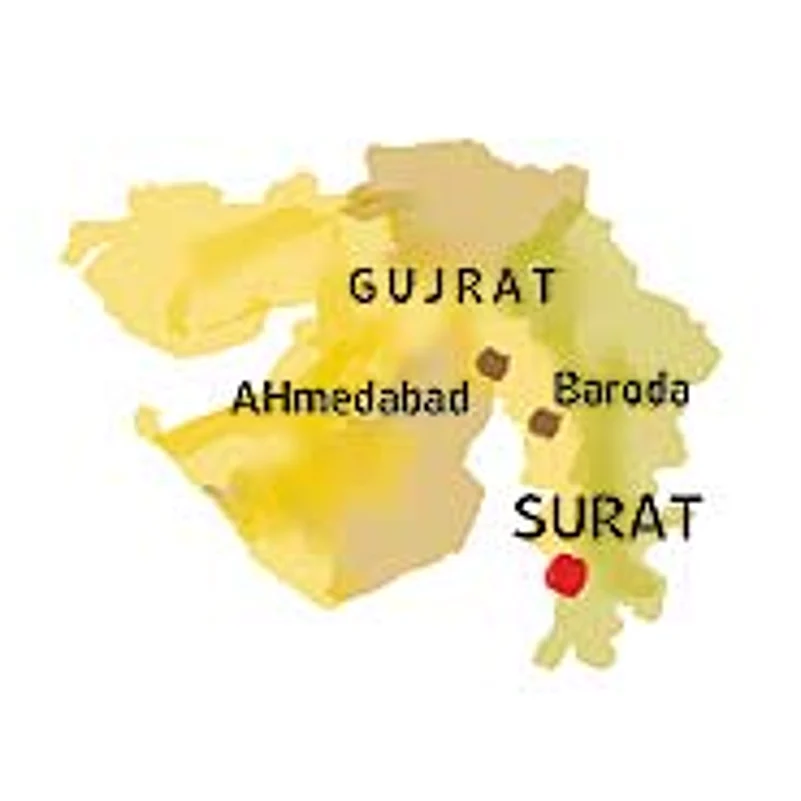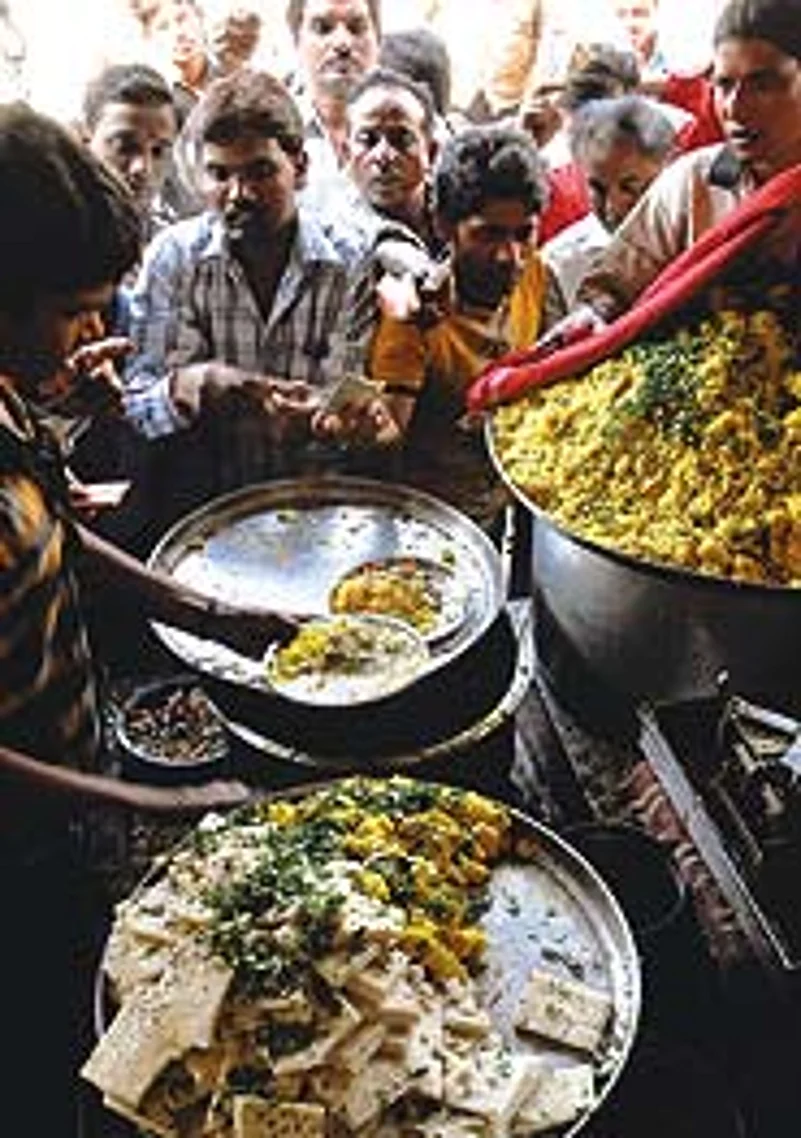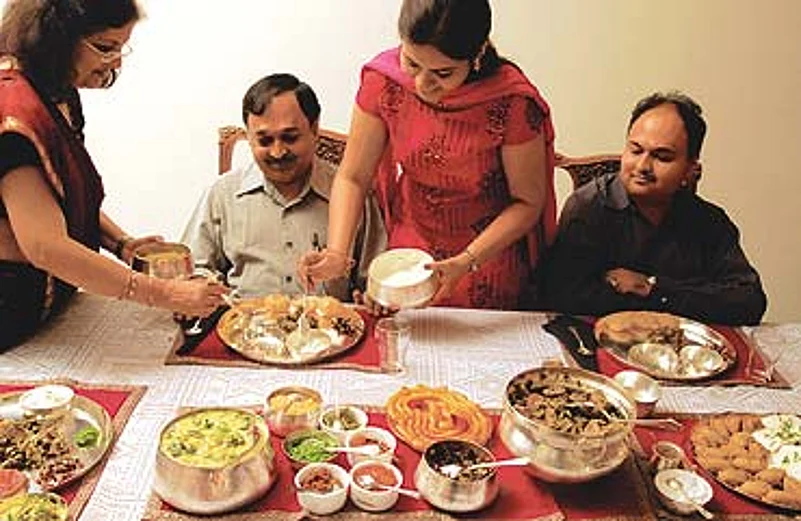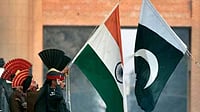
After three decades, I'm back to botany lessons. My teacher, and gracious hostess, is Ketkiben Reshamwala, her surname steeped in a time when Surat romanced silk, instead of carousing with nylon nawabs and diamond sultans. "Not just any brinjals," she says firmly, "but these small, plump, thorny ones. Not any yam, but this purple one we call ratalu..." Into the brass-bottomed pot they disappear, many wondrous veggies I have never known, including masses of a crescent-shaped bean that Gujaratis call Surti papdi. Without this magic bean you can't make undhiyo—the vegetable medley cooked with lots of oil and even more love. The bean's arrival in Surat's bhaji markets has launched a season of festive meals across this city of foodies, and sent thousands of undhiyo-bearing plastic containers spinning across western India, to fussy eaters who like it authentic—with vegetables grown in the alluvial soil around Surat.
Our undhiyo too has slow-cooked to perfection, and around it, elves and fairies are busy arranging side-dishes—spicy banana fritters, little fried half-circles stuffed with toor-dana, ridge gourd cooked with arvi leaves, chunky, fried ratalu slices sprinkled with red chilli powder, a delectable dish of sprouted pulses.... And what I'm coming to recognise as typically Surti cholesterol-laden extravagance—thick, sweet, cardamom- flavoured clotted cream (malai), to be eaten between spicy mouthfuls. Looking down at my silver thali, I count 15 different things!
That's one Surat, and now, this is another. The aroma of vegetables gives way to the smell of cinders, carried on a river breeze; the clinking of elegant silver to a strange, rhythmic sound produced by freshly roasted stalks of green jowar encased in cloth bags, being beaten vigorously by farmhands. We're standing on a bank of the river Tapi, so calm that you almost can't believe its flood waters brought this tough city to its knees in August, and watching a ritual unfold—the harvesting of tiny, emerald beads of young jowar called ponkh. The jowar is of a special variety that grows best—yes, you've guessed right—near Surat.

If undhiyo is party and wedding food, ponkh is al fresco food, in a city of compulsive picnickers, and its short season, from November to January, turns everyone greedy. We watch young women on Honda scooters snapping it up at Rs 180 a kilo. Soon, hands adept at assembling the sweet, sharp and savoury will produce another feast. Once you've eaten tender ponkh with three flavours of crisp sev, including the tantalisingly titled limbumarini (lime and pepper), tiny sugar balls and a tangy chutney made with the green garlic Surtis love, you'll never lust for bhelpuri again.
Is there anything left to look forward to? Resoundingly, yes. For one, the city's full-blooded affair with khaman (of which the spongy dhokla hawked in northern halwai shops is an uncouth cousin). Its inviting yellow greets you, from stalls and carts called laris, in forms that no other Gujarati city can conjure up. For the crowds thronging 50-year-old Jalaram Rasawala Khaman House all day long, it teams up with a hot, spicy curry. Then there's the wildly popular locho, soft, molten khaman, straight out of steam ovens, doused with oil (or, in more cholesterol-laden kindness, melted butter and Amul cheese), and served with a sweet, intensely green chutney.
Also served up in scores of such modest but much-loved eateries dotting Surat's mohallas, are quintessentially Surti qualities like good-humoured efficiency, resilience, generosity and instinctive grace. Droves of opportunity-seeking migrants have doubled Surat's population to 3.5 million in less than 15 years, making it India's ninth largest city. While it's still a city anxiously awaiting an airport, all the other symbols of upward mobility are falling into place—large car showrooms, malls, traffic, pollution, execrable multicuisine restaurants with names like Sugar 'n Spice, trilling teenagers in McDonald's.... But old Surat is holding its own—even if its filigreed balconies are giving away to shopfronts—and nowhere more than on the food trail.
You see it in the unspoken, 10-rupee-a-plate camaraderie among the student in the fake Guess t-shirt and aviator glasses, the small-time diamond merchant with his Innova parked nearby, the retired insurance agent, the pharmacist, all standing around a plastic table and eating off neat squares of Gujarati newsprint at the locho stall. In a pickle-seller's leisurely tale of an old business gone bad, and a new one built up on sheer grit. In the farsan (snack) shop- owner's hospitable admonition to eat first, write later.

And will I ever forget the whacky incongruity of two worlds colliding in 17-year-old Ismael Zhaveri, the failed-jewellery-shopowner-turned-biriyani-maker's son, in his spangled kurti, stone-washed jeans and shoulder length hair? He helps out at the stall, to make his dad happy, but also models—and runs a health club! For biriyani-lovers, no doubt.
On to another memorable experience. In a narrow, purple house in the backlanes of Muslim-dominated Zampa Bazar, in a family room lined with plastic sheets. Before our amazed eyes, Fatima Bibi stretches and stretches a flubber-like ball of maida, incredibly soft after four hours of kneading, until it covers the 15 ft by 12 ft space like a sheet of thin muslin. When the pastry dries, it is cut into 12-inch squares, combined with mawa (reduced milk), and baked. The result is: sagla bagla mithai, sweet but not cloying, and magically delicate.
This single family of bakers, headed by Fatima's husband, Mohammed Khalid Rafat, bakes for a community it does not belong to—the Dawoodi Bohras. No wedding is complete without sagla bagla, which travels to them wherever they live. Laughs Mohammedbhai: "We've made this 105-year-old recipe public. But nobody else can make it, it's hard work." As we leave his home, clutching mithai boxes he will not let us pay for, he nudges us into another room. Another flaky confection, I think. I find myself face to face, instead, with the wine reds, emerald greens and lapis blues of his antique glass collection—lovingly picked up, piece by piece, from the bazaar.
With seven out of ten diamonds in the world cut and polished in Surat, can we really leave without sighting The Rock? We find ourselves in Venus Jewel, a sequestered, high-security world, more Antwerp than India. Its employees—sorting, grading, cutting, polishing—are matriculates, many from nearby rural areas. Presiding over this classy empire, with a $230 million turnover, is another matriculate, founder Sevantilal Shah—a profound, understated man, with nary a diamond on his spare frame.
In his dining room, we're back to the goodness of vegetables, served steaming hot in thalis—to him, to us, and 1,400 employees. Nibbling batter-fried chillies, we hear the story of his communal lunch. It started off as cheap meals for employees, then a decade ago he announced lunch would be free. "I realised my mistake immediately, and apologised. They work here, how could I say I am giving them a free lunch?" Later, he decided to break entrenched caste barriers by inviting scheduled- caste sweepers to lunch. It worked, and still works. Now, that's another taste of Surat to savour, as I leave.


























